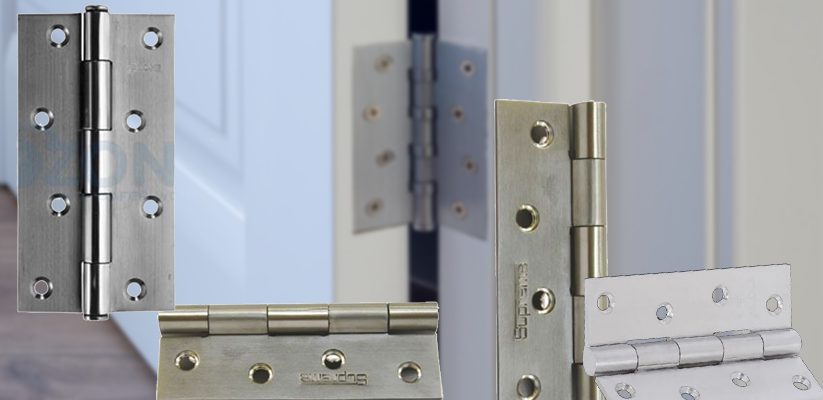Door hinges can vary in price and utility according to the door hinges manufacturers. Though door hinges have been manufactured for a very long time, today’s standardized methods of hinge construction were only introduced very recently. This new era of advanced mass manufacturing with refined machining methods is far more complex than ancient hinge manufacturing. There are many materials used in the process of creating hinges such as tooling, machining techniques, and various base materials. While modern hinge production methods are implemented frequently in the industry, certain characteristics make them stand out in hinge production. In this guide, we will take a closer look at the manufacturing process of door hinges and guide you to make an informed choice about the door hinges available in today’s market.
Materials Used in Hinge Manufacturing
When it comes to cost, efficiency, and decorative applications, the forming material being used for the construction of hinges is the number one factor that determines the durability of hinges. Though door hinges suppliers may stamp their products in order to set their hinges apart from the other manufacturers, there are various materials used in the process of hinge manufacturing. Some of the more commonly used materials used to construct hinges are:

Steel
One of the most popularly employed metals in the market is steel because of its features like mechanical durability and affordability in comparison to other materials. It is an alloy of carbon and iron, but it can still be utilized to form materials. One of the downsides to steel is its ability to rust if applied to places in direct contact with water. It can be fixed with a few treatments such as decorative finishing and painting to make them durable. There are also several applications to install anti-rustic properties in the hinges which can solve this problem.
Brass
Brass is also a very common material used in hinge manufacturing and offers the perfect finish. If you’re looking for aesthetically pleasing applications for door hinges, brass is the way to go. With features such as adaptability to work into various shapes and the ease of fabricating brass, it stands out among all the other materials. Though they are more on the expensive side, the decorative and aesthetic gold hue of brass hinges is what makes them so popular for hinge designs.
Bronze
Bronze is another popular material, particularly known for its metal-to-metal friction level and its easy manufacturing. It is an alloy of tin and copper and provides a reddish surface color, making it aesthetically decorative for many applications.
Hinge Manufacturing Process
The hinge manufacturing process involves various steps. This complex method requires the following steps to automate the manufacturing of door hinges.
Extrusion
During this step, the metallic part is forced with a lot of applied pressure in the die. In order for the hinges to form into different shapes, the extrusion process is applied to create high-quality stamped hinges. Though extruded hinges are pricey, they are produced to meet the needs of a wide variety of homeowners.
Deformation
This step contains rolling, spinning, bending, and forging materials to form various types of hinges through special machines. Deformation also involves other methods of stretching and applying to punch to create the best results. These essential features can keep check on quality-control for the production of door hinges.
Cutting
Since hinges are manufactured with large parts of metal, this process involves detaching excess materials from the metal workpiece. Through cutting techniques to effectively carve the hinges, the excess parts of the hinges are removed. This process can involve shearing, drilling, sawing, or more complex methods like laser.
Secondary Processes
After all the main steps of hinge manufacturing process are completed, secondary processes are required to help with hinge deterioration. These peripheral treatments can help the hinges in the desired shape and prove to be aesthetically pleasing. This is essential to keep the hinges in the best condition. These are the following processes most commonly used to finish the door hinge manufacturing process.
- Ball Bearings: Applying ball bearings can make it easier and smoother to open doors. Door hinges are fitted with ball bearings to make them slide over each other and connect two parts.
- Painting: The application of paint is another crucial process used to enhance and refine the appearance of hinges. Steel is one of the many materials known to rust but painting can lower the chances of corrosion by creating a protective seal.
- Burnishing: This process is used to give the hinges a decorative appeal by rolling and rubbing them against other metals. It is essential to improve the aesthetic value of a household and all the accessories where the hinges are fitted.
- Polishing: Polishing can help maintain the perfect finish on the hinges. In the polishing process, there are many steps involved to enhance their condition and apply smoothing methods that will form a seamless finish for the door hinges.
- Rust-proofing: This process is essential to treat the rust on the hinges. There are various reasons hinges can acquire corrosion or rust. Whether it’s exposure to certain weather or wearing out, the hinges must be built to last a lifetime by applying the necessary rust-proofing methods.

Conclusion
The door hinge manufacturing process involves all these critical steps to achieve the best results for the interior and exterior settings of your household. There are many factors that contribute to maintaining the aesthetic value in your household, and door hinges can be little but significant additions to improve your home decor. Thus, it is crucial to buy high-quality hinges manufactured with the best materials to last a lifetime and add substantial value to your house.






